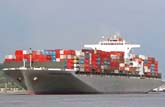After AXS-Alphaliner reported a decrease in idled container ship capacity during the first half of April, the first dip in six months, experts are predicting a surge of overcapacity by the end of the year.
According to AXS-Alphaliner, 485 vessels of 1.42 million TEU were idle at the end of March, representing 11.3% of the global fleet.
By April 13th, although the vessel count was 486, the idled capacity had dropped to 1.31 million TEU or 10.4% of the fleet.
BIFA says that the idled fleet will shrink in the coming months as recently suspended seasonal loops, and larger ships on other loops, are re-introduced. Shipping companies, K-Line, COSCO, OOCL, Hanjin and MOL, amongst others, are also anticipating a re-deployment of laid-up vessels as idle fleet capacity picks up.
That said, Alphaliner warns that the bleak economic outlook could see the idle fleet soaring up to more than two million TEU after the peak of the season.
Meanwhile, Drewy Shipping Consultants has expressed concerns carriers are doing little to cut capacity.
In its report "Capacity Management - Surviving the Container Crisis," Drewy emphasises the need for container lines to cancel more orders, scrap older ships and lay-up newer ships. Whilst carriers have so far cut capacity from 20% to 25%, this has achieved little in preventing depleted freight rates.
The problem extends beyond shipping, and into the ocean-, rail- and airfreight sectors, and last month FedEx announced plans to cut fourteen widebody aircraft from its fleet.
Eyefortransport













